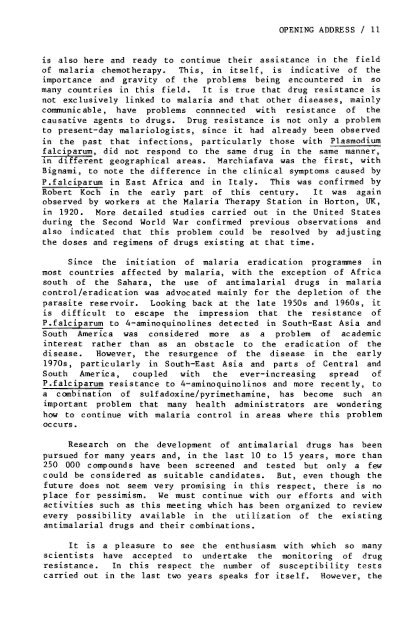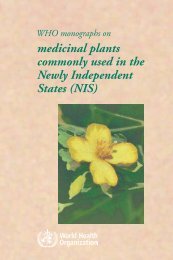Drug-Resistant Malaria - libdoc.who.int - World Health Organization
Drug-Resistant Malaria - libdoc.who.int - World Health Organization
Drug-Resistant Malaria - libdoc.who.int - World Health Organization
Create successful ePaper yourself
Turn your PDF publications into a flip-book with our unique Google optimized e-Paper software.
OPENING ADDRESS / 11<br />
is also here and ready to continue their assistance in the field<br />
of malaria chemotherapy. This, in itself, is indicative of the<br />
importance and gravity of the problems being encountered in so<br />
many countries in this field. It is true that drug resistance 1S<br />
not exclusively linked to malaria and that other diseases, mainly<br />
communicable, have problems connnected with resistance of the<br />
causative agents to drugs. <strong>Drug</strong> resistance is not only a problem<br />
to present-day malariologists, since it had already been observed<br />
in the past that infections, particularly those with Plasmodium<br />
falciparum, did not respond to the same drug in the same manner,<br />
in different geographical areas. Marchiafava was the first, with<br />
Bignami, to note the difference in the clinical symptoms caused by<br />
P. f alciparum in East Africa and in Italy. This was confirmed by<br />
Robert Koch in the early part of this century. It was again<br />
observed by workers at the <strong>Malaria</strong> Therapy Station in Horton, UK,<br />
in 1920. More detailed studies carried out in the United States<br />
during the Second <strong>World</strong> War confirmed previous observations and<br />
also indicated that this problem could be resolved by adjusting<br />
the doses and regimens of drugs existing at that time.<br />
Since the initiation of malaria eradication programmes in<br />
most countries affected by malaria, with the exception of Africa<br />
south of the Sahara, the use of antimalarial drugs in malaria<br />
control/eradication was advocated mainly for the depletion of the<br />
parasite reservoir. Looking back at the late 1950s and 1960s, it<br />
is difficult to escape the impression that the resistance of<br />
P. f ale iparum to 4-aminoquino lines detec ted in South-East Asia and<br />
South America was considered more as a problem of academic<br />
<strong>int</strong>erest rather than as an obstacle to the eradication of the<br />
disease. However, the resurgence of the disease in the early<br />
1970s, particularly in South-East Asia and parts of Central and<br />
South America, coupled with the ever-increasing spread of<br />
P.falciparum resistance to 4-aminoquinolinos and more recently, to<br />
a combination of sulfadoxine/pyrimethamine, has become such an<br />
important problem that many health administrators are wondering<br />
how to continue with malaria control in areas where this problem<br />
occurs.<br />
Research on the development of antimalarial drugs has been<br />
pursued for many years and, in the last 10 to 15 years, more than<br />
250 000 compounds have been screened and tested but only a few<br />
could be considered as suitable candidates. But, even though the<br />
future does not seem very promising in this respect, there is no<br />
place for pessimism. We must continue with our efforts and with<br />
activities such as this meeting which has been organized to review<br />
every possibility available in the utilization of the existing<br />
antimalarial drugs and their combinations.<br />
It 1S<br />
scientists<br />
resistance.<br />
carried out<br />
a pleasure to see the enthusiasm with which so many<br />
have accepted to undertake the monitoring of drug<br />
In this respect the number of susceptibi lity tests<br />
in the last two years speaks for itself. However, the
















